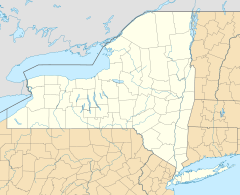Dry Brook (Cannonsville Reservoir tributary) facts for kids
Quick facts for kids Dry Brook |
|
|---|---|
|
Location of the mouth of Dry Brook
|
|
| Country | United States |
| State | New York |
| County | Delaware |
| Physical characteristics | |
| Main source | 42°10′31″N 75°19′38″W / 42.1752778°N 75.3272222°W |
| River mouth | Cannonsville Reservoir 1,148 ft (350 m) 42°07′45″N 75°18′34″W / 42.1292509°N 75.3093407°W |
| Basin features | |
| Tributaries |
|
Dry Brook is a small river or stream located in Delaware County, New York. It flows into the Cannonsville Reservoir, which is a large body of water that stores drinking water for many people. This brook is an important part of the local water system in the Catskill Mountains region.
Contents
Where is Dry Brook?
Dry Brook is found in the beautiful state of New York, within Delaware County. This area is known for its rolling hills and natural beauty. The brook starts its journey in the countryside of Delaware County.
Its Journey to the Reservoir
The brook flows generally southwest. It travels through natural landscapes before reaching its final destination. Dry Brook eventually empties into the Cannonsville Reservoir. This reservoir is located northeast of a place called Stilesville.
What is a Reservoir?
A reservoir is like a giant, artificial lake. It is built to store water, often for drinking or to help control floods. The Cannonsville Reservoir is a very important source of drinking water for New York City.
Other Streams Joining In
As Dry Brook flows, other smaller streams join it. One of these is called Barbour Brook. When smaller streams join a larger one, they are called tributaries. These tributaries add more water to Dry Brook as it makes its way to the reservoir.
Why is Dry Brook Important?
Even though Dry Brook is a small stream, it plays a role in the environment. It helps carry water from the land into the larger reservoir. This water eventually becomes part of the drinking supply for many people. Protecting streams like Dry Brook helps keep our water clean and healthy.


